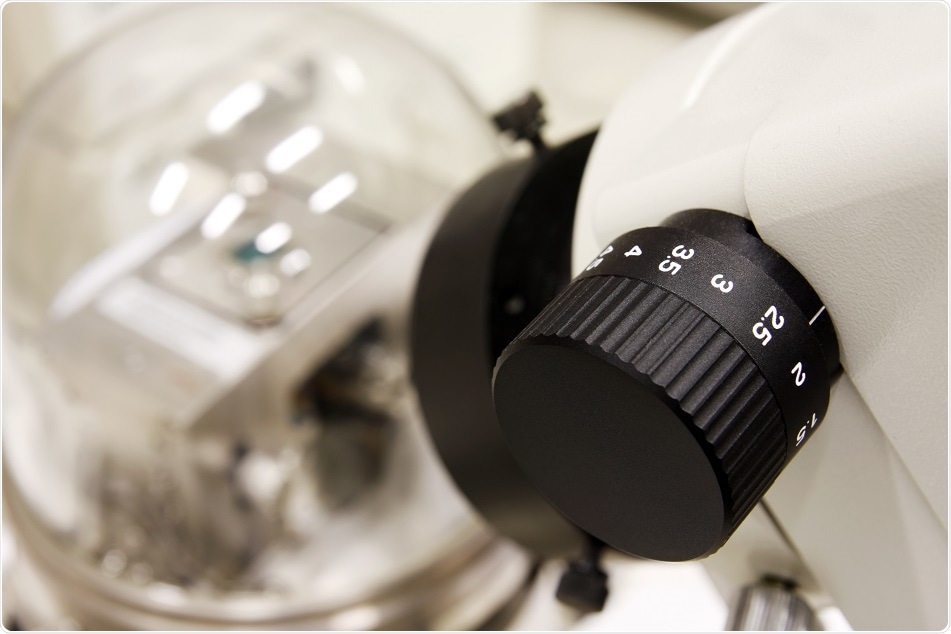Advances in material science combined with nanofabrication and computational design have led to the discovery of label-free protein microarray techniques. These techniques are of enormous benefit for protein profiling, biomarker screening, drug discovery, drug target identification, and for our knowledge of signaling pathways in disease.

Credit: Alexander Gatsenko/ Shutterstock.com
They allow analysis and insights into a wide range of molecular interactions simultaneously at a single setting. In these techniques, false positives as well as conjugated labels are avoided, consistent dynamic parameters are made available, and the detection methods are easily reproducible, all due to direct observations of biomolecules and their features.
Key microarray technologies
Microarray technologies involve (1) a functional capture agent, (2) surface chemistry, and (3) generation of high efficiency throughput methods. These three must be tightly merged with each other in order to provide accurate and best protein detection.
The following are some of the label-free protein microarray detection methods. These methods provide more direct information as they make use of innate proteins and ligands.
Mass spectrometry
Mass spectrometry (MS) is an approach in which proteins are identified after tryptic digestion by way of patterns of molecular mass.
An innovative MS approach is surface-enhanced laser desorption/ionization (SELDI) TOF-MS. This approach proffers on-chip purification of the selected protein and ionization of the molecules retained for detection.
The technique has been successfully applied for identification of proteins in chip format and for screening of tumor biomarkers and plant phosphoproteome.
Other disease marker proteins that were identified include rat plasma profiling for biomarker discovery, amyloid β-peptides, downregulated biomarker identification, and liver cirrhosis protein classification.
The limitations include no spatial resolution for high-density detection limits and MS. The setup is bulky and sophisticated, and protein abundance requires the existence of a calibration curve.
Microcantilevers
Also called Kelvin probes, microcantilevers were originally used in atomic force microscopy for the purpose of surface characterization. These probes involve in differential stress such as transduction of specific biomolecules to nanomechanical signals. Due to protein interaction there is deformation in the cantilever, and interaction can be seen by following the changes using a laser beam.
The technique is used to analyze biomarkers, weigh viruses and bacteria, detect DNA-binding proteins, and detect anthrax (an agent of bioterrorism). It is an efficient measurement method for research studies and is integrated with a microfluidic channel.
Currently, this technique suffers from limitations of no integration between cantilever arrays and microfluidic networks, and non-standard variations in the performance.
Quartz crystal microbalance
Quartz crystal microbalance (QCM) is a well-known technique making use of acoustic waves for investigation of molecular adsorption and surface reactions by monitoring changes in the resonant frequency. The QCM surface comprises a thin gold surface. The quartz frequency changes for substances adsorbed by the QCM surface, which in turn change into an electric field that is detectable.
This technique is of great convenience for study of protein adsorption, real-time biological reactions, and other surface-related processes in liquids. Recently, the technique has been extended to include measuring simultaneously the dissipation of energy, which provides added knowledge about the process of protein adsorption. Multichannel detection on a single chip system is also possible.
Surface plasmon resonance and localized surface plasmon resonance
Surface plasmon resonance (SPR) is one of the most dependable techniques for study of protein interactions, especially in kinetic and thermodynamic analysis. Two-dimensional 2-cm wide microfluidic chips are used for detection. Adaptations to protein microarrays are done by modifying the technique as SPR imaging and SPR with coupled grating. SPR imaging has the capability to record light reflected as a function of time in a single fixed incidence angle. It can also monitor more than a thousand real-time interactions simultaneously.
Localized SPR (LSPR) was introduced in the year 2000. LSPR can sensitively detect interactions using a 76 × 26 mm chip consisting of 300 spots. The fabrication costs of LSPR are much lower than sensors based on SPR, hence the former are suitable for commercial purposes. Recent e-beam technologies can fabricate very dense nanoparticle arrays for high throughput biochips.
Some hindrances to the progress of the LSPR biosensor are the relatively short dynamic range and the process by which nanoparticles become immobilized to the solid surfaces. Accurate fabrication design and LSPR chips for quick and considerable screening are the current requirements.
Anomalous reflection
Anomalous reflection (AR) is a promising technique that uses gold to observe biomolecular interactions. Reduced reflectivity is observed at wavelengths of 400–500 nm when a molecular layer forms on the gold surface. The change in reflectivity is monitored for detection of molecular interactions.
The technique has a number of advantages. Quantitative measurement of proteins is possible by the technique of transfer matrix, semi-infinite thin film gold of over 100 nm is allowed for AR detection, and tolerance toward the incidence angle allows light emitting diodes to be used. It is portable, can be miniaturized, and the spatial resolution is almost 10 times lesser than SPR.
Further Reading